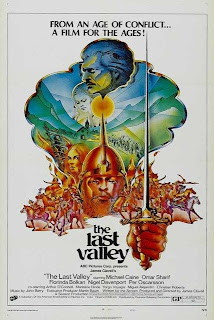In a time where the world was shocked by hate and consume by war. When a man had nowhere to run, no pace to hide, suddenly, there was a valley, the Last Valley.
And into this valley, came two man, a man of violence [The Captain] "Break open every house, then round-up the peasants, fire the village at leisure"
And a man of peace [The Teacher] "Why such waste? Went to here, leave while your army dies."
Michael Caine as the Captain: "If to kill is necessary, I do it, without conscience"
Omar Sharif as the teacher: "I bring a message from the Captain. Captain undertakes to protect your village from other soldiers on conditions that he and his men be will billated for the winter. If not your valley will die.
There goal were very differents. There ideas were very so much the same.
[The Captain]: There is no just rules
[The Teacher]: Millions of settlers more will dire
[The Captain]: Your leaders are bigots
[The Teacher]: 'Cause the pope wars on the Catholic Emperor
[The Captain]: Your generals are bandits
[The Teacher]: He wars on the Catholic King of France
[The Captain]: You employ any muscle that you can get
[The Teacher]: He wars on the catholic king of Spain
[The Captain]: And the Pope plays politics
[The Teacher]: And by hundred are the princes ans kings and bishops. All by their own rotten purposes
[The Captain]: All sides are rotten, except by people like you. Religious fanatics who incite to murder for the sake of a god they have never known. Don't you understand ? There is no God!
One stood for war, one stood for peace between them a lost valley, the Last Valley.









